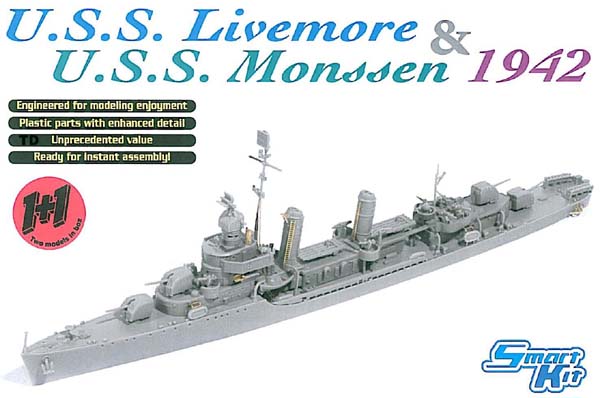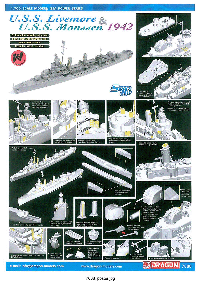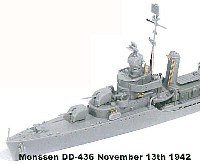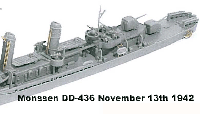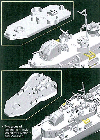| The Monssen (DD -436) was commissioned 14 March 1941. After shakedown
and training, Monssen reported to the Atlantic Fleet on 27 June 1941 as
a unit of DesDiv 22. For the next 5 months she operated in the northwestern
Atlantic participating in the neutrality patrol. On 9 February 1942 she
entered the Boston Navy Yard for overhaul in preparation for her transfer
to the Pacific Fleet. Her first action upon joining TF16 was as part of
the antisubmarine screen for Hornet (CV-8) as the carrier headed towards
Japan with Doolittle's B-25's on her flight deck.
After returning to Pearl Harbor they sortied 30 April to aid Yorktown
(CV-5) and Lexington (CV-2) in the Battle of the Coral Sea, but reached
the scene after the battle was over. TF16 returned to Pearl Harbor and
departed again, this time for the Battle of Midway. After Midway the force
remained at Pearl Harbor for a month before departing for the Solomon Isles
by way of the Tonga Islands. On the 7th and 8th of August, Monssen with
Buchanan (DD-484) stood off Gavutu and Tanambago, circling those islands
and providing fire support to units of the 2d Marine Regiment. She was
then assigned to the screening forces guarding the eastern approaches to
Sealark, Lengo, and Nggela Channels.
Monssen was one of the ships designated to escort Saratoga (CV-3) to
the Tonga Islands after she was damaged in the Battle of the Eastern Solomons
She then took up duties patrolling the sea routes to Guadalcanal.
Monssen returned to Guadalcanal 18 September to insure the integrity
of an Allied supply line and to block Japanese efforts at resupply. On
8 November, she departed Noumea with two cruisers and two other destroyers
as TG 67.4, under Rear Admiral Callaghan, as escort for transports carrying
reinforcements to the marines on Guadalcanal. At the same time, another
convoy set out from Espiritu Santo, covered by one cruiser and four destroyers
under Rear Admiral Scott. Arriving off Lunga Point on the 12th, a day after
those from Espiritu Santo they commenced unloading. By dusk as reports
of Japanese ship movements from Truk increased, 90 percent of the transports
had been unladen despite afternoon torpedo plane attacks, one of which
had cost Monssen the use of her fire control radar. The transports were
pulled out, escorted through Lengo Channel, and seen safely on their way
to Espiritu Santo. Then Admiral Callaghans force, heavily outnumbered even
with the addition of, Admiral Scott's ships reversed course and steamed
back to engage the enemy in the initial action of what would later be called
the Naval Battle for Guadalcanal.
Shortly, after 0140, 13 November, they sighted the enemy fleet, under
Vice Admiral Abe, 3 miles north of Kukum. The enemy was headed toward Henderson
Field to bombard it and cripple Allied air operations long enough to sneak
in 11 of their transports, then en route to relieve their beleaguered comrades
fighting on the island.
Battle was given at 0150. At about 0220 Monssen forced to rely on radio
information and optics, was spot lighted, hit by some 37 shells, and reduced
to a burning hulk. Twenty minutes later, completely immobilized in all
departments, the ship was ordered abandoned. After daybreak Monssen was
still a floating incinerator. C. C. Storey, BM2c, L. F. Sturgeon, GM2c,
and J. G. Hughes F1c, climbed back into the inferno and rescued eight men
still aboard and alive, five of whom lived after reaching land. The survivors,
40 percent of the crew, were picked up at about 0800 and taken to Guadalcanal.
The ship itself continued to blaze until early afternoon, when the waters
of Ironbottom Sound closed over her.
Monssen was awarded four battle stars for World War II service. |
